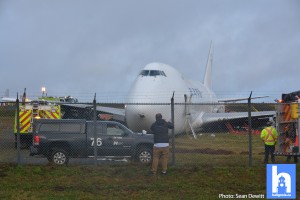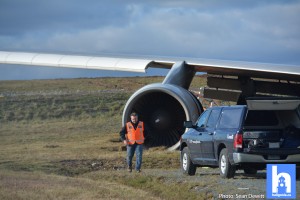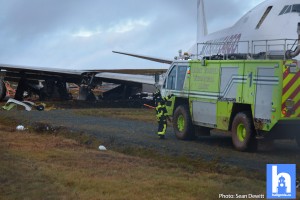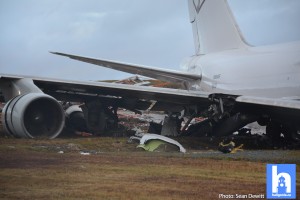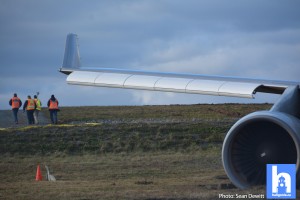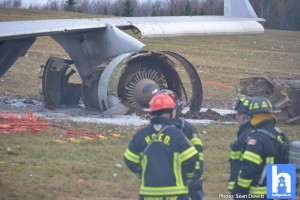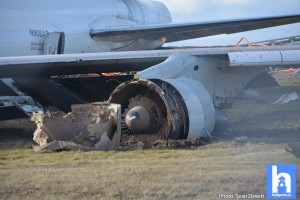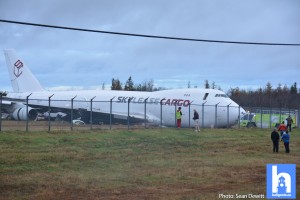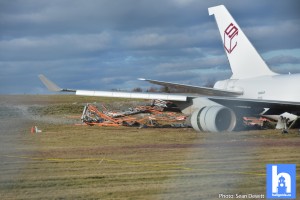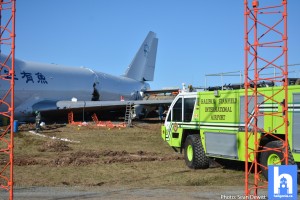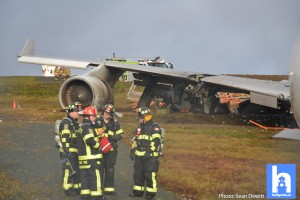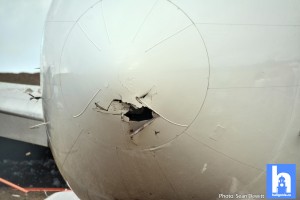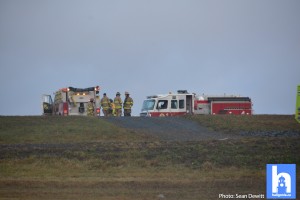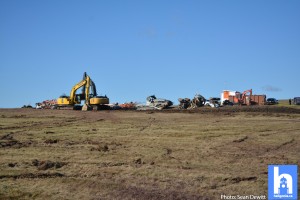The occurrence
On 7 November 2018, at about 0505 Atlantic Standard Time (AST), a Sky Lease Cargo Boeing 747 overran Runway 14 of the Halifax/Stanfield International Airport.
The aircraft came to rest off the end of the runway.
There were 4 crew members on board. The TSB is investigating.
What we know
- On 7 November 2018, at about 0505 AST, a Boeing 747-400 cargo aircraft operated by Skylease Cargo overran Runway 14 of the Halifax/Stanfield International Airport, coming to rest approximately 695 feet, or 210 metres, off the end of the runway. The aircraft was on a flight from Chicago/O’Hare International Airport to Halifax Stanfield International Airport.
- There were 4 crew members and no passengers nor any cargo on board at the time of the occurrence. Minor injuries to the 4 crew members were reported following the occurrence, and the aircraft was substantially damaged.
- There was a strong westerly wind gusting at 18 knots, which would be approximately 33 mph. It was raining at the time of the occurrence. In more technical terms, according to METAR issued 7 minutes before arrival, the winds were 250 degrees, 11 gusting 18 knots. The ceiling was 1,200 feet above ground and visibility was 8 miles.
- The aircraft struck a localizer antenna during the overrun. Its landing gear collapsed, two engines separated from the aircraft, and the remaining engines were substantially damaged. A small post-impact fire originated from the detached No. 2 engine which was lodged under the tail of the aircraft.
- Runway overruns are a TSB Watchlist issue. Since 2013, there have been an average of 9 overrun accidents and incidents every year in Canada. These can lead to aircraft damage, injuries and loss of life. The consequences can be particularly serious when there is no adequate runway end safety area (RESA) or suitable arresting material (see the video).
- The TSB has 4 outstanding recommendations aimed at reducing the number of runway overruns, and minimizing risks should an overrun occur.
Progress to date
The investigation team has conducted the following information-gathering work:
- The flight data recorder, cockpit voice recorder, along with other systems aboard the aircraft that contain flight data are being recovered. These will be sent to the TSB’s Engineering Laboratory in Ottawa for analysis.
- An initial examination of the accident site has been conducted.
- A thorough examination of Runway 14/32 has been conducted.
- The investigation team is in contact with the Skylease, the US National Transportation Safety Board (NTSB), the American Federal Aviation Administration (FAA), the manufacturers Boeing and Pratt & Whitney, the Halifax Airport Authority, NAV CANADA and Transport Canada.
- Transport Canada has appointed a Minister’s Observer who will obtain factual information and advise the Department of any significant regulatory factors. He or she might also identify deficiencies that require immediate corrective actions and coordinate the required support to the investigation.
- The TSB investigation team will be augmented with investigators from Head Office, Quebec and Western Regions, HumanFactors, Engineering Laboratory and Communications.
Next steps
In the coming days and weeks, investigators will do the following:
- Download and analyze the data from the aircraft’s cockpit voice recorder and flight data recorder.
- Conduct interviews with witnesses, air traffic control, and airport personnel and others who may provide additional information useful to the investigation.
- Thoroughly review audio and radar data from NAV CANADA.
- Gather and analyze all available information about the weather and runway surface conditions at the time of the occurrence.
- Examine aircraft systems, review the aircraft maintenance records, pilot training, qualifications and proficiency records.
- Review policies, operational procedures and regulatory requirements.
- Examine the terrain at the end of the runway at Halifax/Stanfield Airport to determine what role it played in aircraft damage.
Communication of safety deficiencies
Aircraft accident investigations are complex and the TSB will take the time it needs to complete a thorough investigation.
However, should we uncover safety deficiencies that present an immediate risk, we will communicate them without delay.
It is important not to speculate or draw conclusions about the causes of occurrences. Several factors usually contribute to an accident.
Transportation Safety Board investigation process
There are 3 phases to a TSB investigation:
- Field phase: a team of investigators examines the occurrence site and wreckage, interviews witnesses and collects pertinent information.
- Examination and analysis phase: the TSB reviews pertinent records, tests components of the wreckage in the lab, determines the sequence of events and identifies safety deficiencies. When safety deficiencies are suspected or confirmed, the TSBadvises the appropriate authority without waiting until publication of the final report.
- Report phase: a confidential draft report is approved by the Board and sent to persons and corporations who are directly concerned by the report. They then have the opportunity to dispute or correct information they believe to be incorrect. The Board considers all representations before approving the final report, which is subsequently released to the public.
.
Source : Media Release / Transportation Safety Board of Canada
.
.

